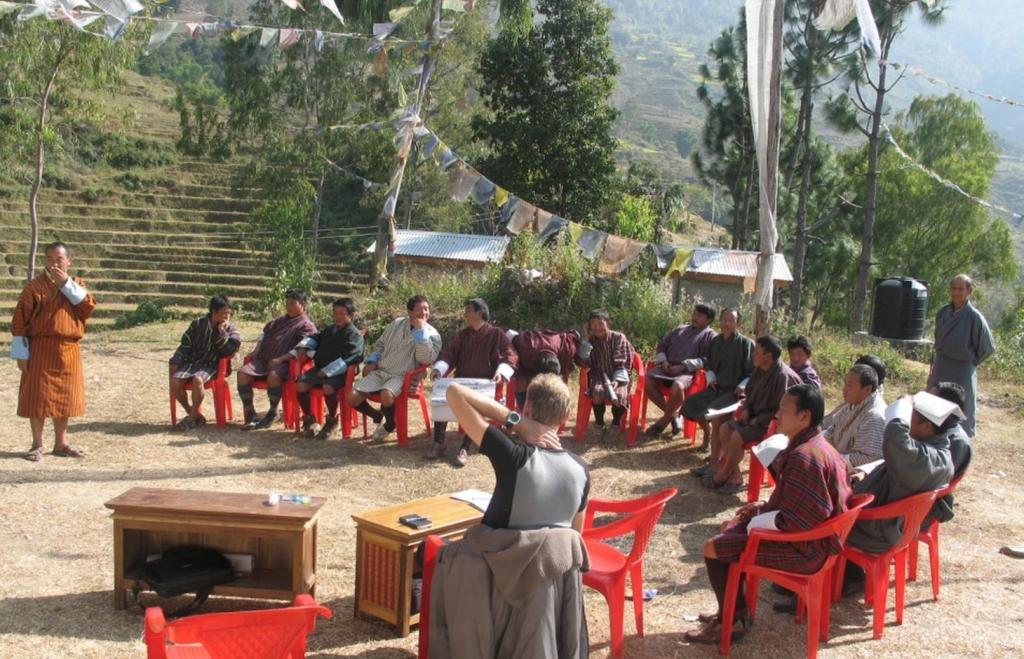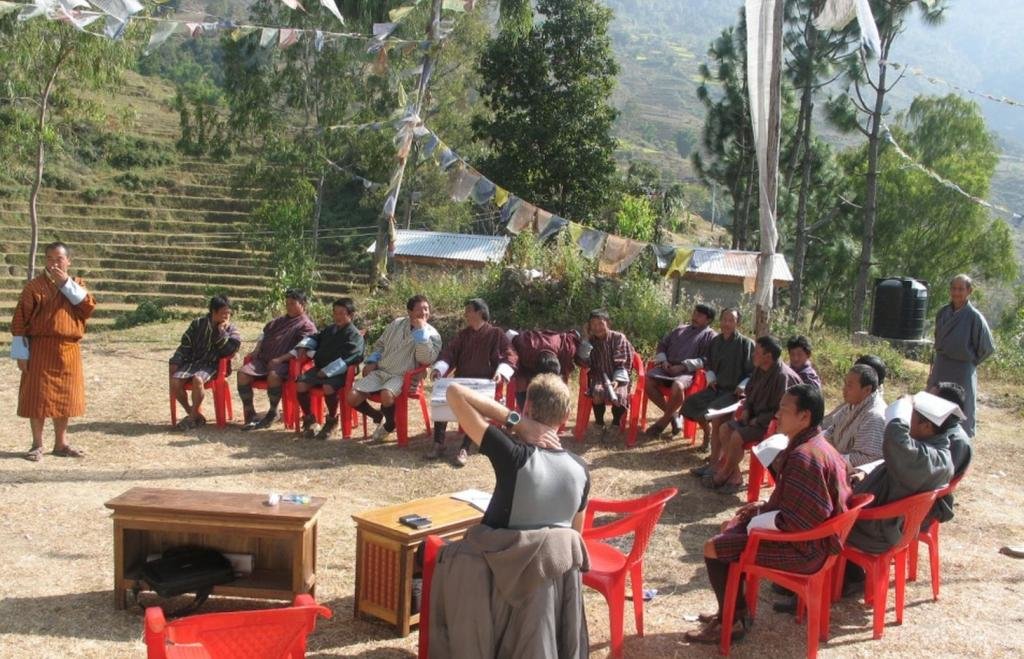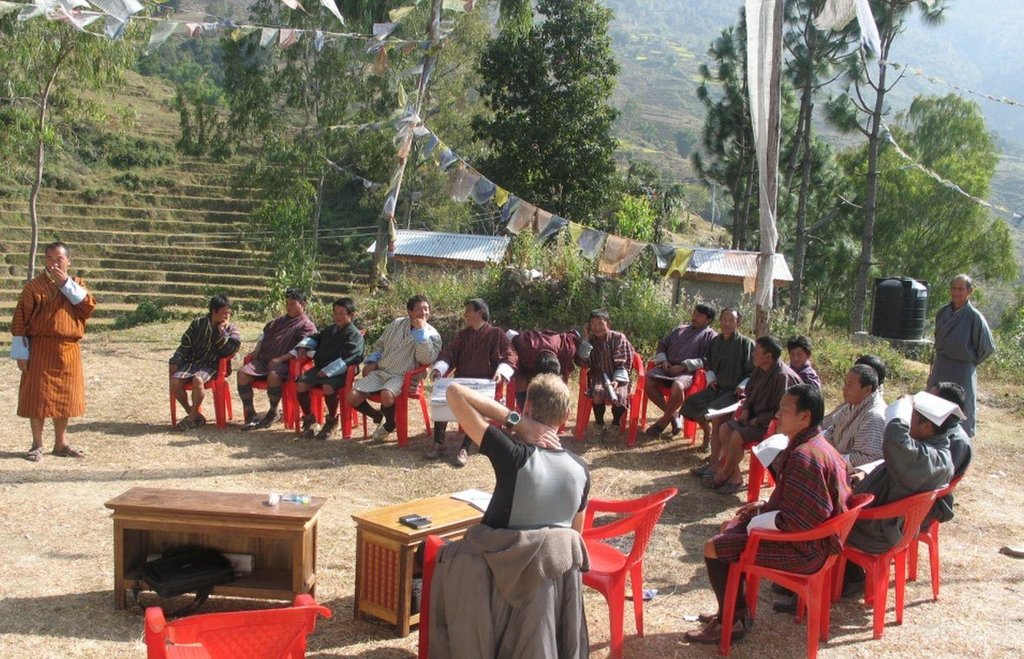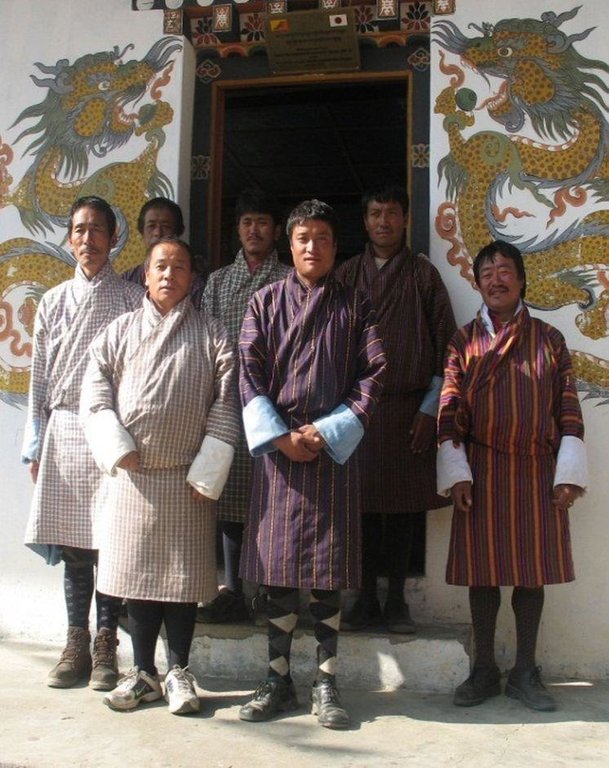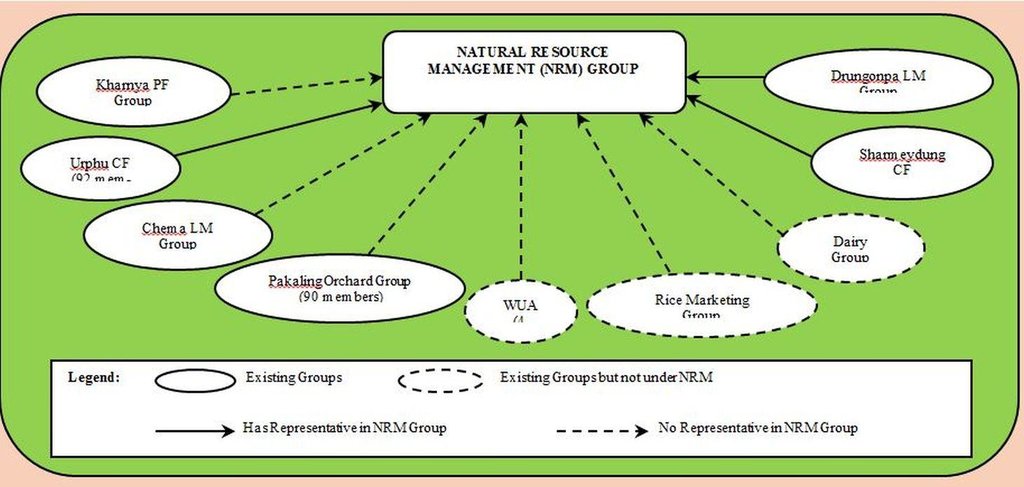Natural Resource Mangement Group [ภูฏาน]
- ผู้สร้างสรรค์:
- การอัพเดท:
- ผู้รวบรวม: Karma Dorji
- ผู้เรียบเรียง: –
- ผู้ตรวจสอบ: Fabian Ottiger
Rangzhing Nitang Sunchop Tshogpa (Dzongkha)
approaches_2492 - ภูฏาน
ดูส่วนย่อย
ขยายทั้งหมด ย่อทั้งหมด1. ข้อมูลทั่วไป
1.2 รายละเอียดที่ติดต่อได้ของผู้รวบรวมและองค์กรที่เกี่ยวข้องในการประเมินและการจัดเตรียมทำเอกสารของแนวทาง
ชื่อของโครงการซึ่งอำนวยความสะดวกในการทำเอกสารหรือการประเมินแนวทาง (ถ้าเกี่ยวข้อง)
MoA (MoA) - ภูฏานชื่อของโครงการซึ่งอำนวยความสะดวกในการทำเอกสารหรือการประเมินแนวทาง (ถ้าเกี่ยวข้อง)
National Soil Services Centre (National Soil Services Centre) - ภูฏาน1.3 เงื่อนไขที่เกี่ยวข้องกับการใช้ข้อมูลที่ได้บันทึกไว้ผ่านทาง WOCAT
วันที่เก็บรวบรวมข้อมูล (ภาคสนาม):
23/03/2011
ผู้รวบรวมและวิทยากรหลักยอมรับเงื่อนไขเกี่ยวกับการใช้ข้อมูลที่ถูกบันทึกผ่านทาง WOCAT:
ใช่
2. คำอธิบายของแนวทาง SLM
2.1 การอธิบายแบบสั้น ๆ ของแนวทาง
Natural Resource Management Group consisting of village representatives to advocate, plan and implement SLM activities at geog level
2.2 การอธิบายอย่างละเอียดของแนวทาง
การอธิบายอย่างละเอียดของแนวทาง:
Aims / objectives: The Natural Resource Management (NRM) Group was formally established in Radhi geog in 2000 with representatives from all 20 chiogs of the geog. The main tasks of the group are to :1)mobilise local communities in rehabilitating and protecting natural resources from further degradation and 2) to support geog administration, RNR staff and other agencies in planning, implementing and monitoring sustainable natural resource management activities. Radhi geog in Trashigang Dzongkhag, East-Bhutan, has been confronted with severe land degradation as a result of unsustainable land management practices, such as deforestation, overgrazing and poor irrigation water management. The land degradation processes are related to high population pressure and a series of conflicts between chiogs and with neighbouring geogs about use and access to natural resources. Various stakeholders, engaged with reduction and mitigation of land degradation in Radhi, felt the need for a local institution, which should play a pivotal role in advocacy of sustainable management of natural resources. The group was also intended to assist in implementing remedial and preventive measures at village level.
Methods: The NRM group fulfilled a key role in the afforestation program for the Radhi wa-tershed, in particular the very active Chongdiri ravine, which has caused wide-spread loss of arable land and forced resettlement of households, because of a very active landslide area. The chiog representatives, united in the NRM group, mobilized villagers to actively participate in the afforestation and fencing of the buffer zone. This zone was created to arrest the critical land degradation and change unsustainable land management practices, such as free grazing cattle and irrigated paddy cultivation in an active mass movement area.
Seed money was provided to establish a group fund to provide small-scale loans to households for agricultural inputs in order to overcome existing credit access constraints. The intention was to enhance the viability and sustainability of the NRM Group.
Stages of implementation: Over the last 5 years approximately 250 loans have been disbursed of about US$60 each. The NRM group has a loose umbrella function at geog level over a number of sub-groups at chiog level, related to private forestry, community forestry, bamboo and rice marketing, water user associations and land man-agement. The present group structure needs to be reviewed to adapt to the large number of emerging sub-groups.
2.3 รูปภาพของแนวทาง
2.5 ประเทศ ภูมิภาค หรือสถานที่ตั้งที่ได้นำแนวทางไปใช้
ประเทศ:
ภูฏาน
ข้อมูลเฉพาะเพิ่มเติมของสถานที่ตั้ง:
Trashigang Dzongkhag, Radhi geog
2.6 วันที่เริ่มต้นและสิ้นสุดของแนวทาง
ระบุปีที่เริ่ม:
2000
การสิ้นสุดลง (ถ้าแนวทางไม่ได้ใช้อีกต่อไป):
2012
2.7 ประเภทของแนวทาง
- ใช้โครงงานหรือแผนงานเป็นฐาน
2.8 เป้าหมายหรือวัตถุประสงค์หลักของแนวทาง
The Approach focused mainly on SLM with other activities (cash-income generation, NRM fund for SLM loans/credit facility)
- The main tasks of the group are to: 1) mobilise local communities in rehabilitating and protecting natural resources from further degradation and 2) to support municipality administration, RNR staff and other agencies in planning, implementing and monitoring sustainable natural resource management activities. A series of government programmes and projects initi-ated activities in Radhi geog and it was decided to create a local institution focused at building capacity in NR management, awareness raising and sensitization.
The SLM Approach addressed the following problems: - Widespread severe land degradation in densely populated area, related to forest degradation, overgrazing, poor irrigation water management, unfavourable geological conditions and NR management conflicts between chiogs and between geogs
2.9 เงื่อนไขที่เอื้ออำนวยหรือเป็นอุปสรรคต่อการนำเทคโนโลยีภายใต้แนวทางนี้ไปปฏิบัติใช้
บรรทัดฐานและค่านิยมทางสังคม วัฒนธรรม ศาสนา
- เป็นอุปสรรค
Conflicts between geogs (Radhi and Merak) over grazing rights and access, combined with conflicts between chiogs within Radhi over land and water use rights, all contributing to serious land degradation issues in Radhigeog
Treatment through the SLM Approach: Group meetings with chiog representatives; conflict mitigation workshops; formal conflict mitigation and eventually even formal judicial court cases; group formation and support to mitigate land degradation issues and come to consensus
การมีไว้ให้หรือการเข้าถึงแหล่งการเงินและบริการ
- เป็นอุปสรรค
Limited access to agricultural credit facilities
Treatment through the SLM Approach: Establishment of a local NRM group fund
กรอบแนวทางในการดำเนินการด้านกฎหมาย (การถือครองที่ดิน สิทธิในการใช้ที่ดินและน้ำ)
- เอื้ออำนวย
The existing land ownership, land use rights / water rights moderately helped the approach implementation: Widespread land tenure facilitates participation level of land users in NRM/SLM activities. Government owned forests have partly been converted to Community Forests, now owned and managed by the local communities. Traditional grazing rights however, have created serious long-lasting inter-geog conflicts that have proved to be difficult to resolve, despite many mediation and judicial efforts.
3. การมีส่วนร่วมและบทบาทของผู้มีส่วนได้ส่วนเสียที่เกี่ยวข้อง
3.1 ผู้มีส่วนได้ส่วนเสียที่เกี่ยวข้องในแนวทางนี้และบทบาท
- ผู้ใช้ที่ดินระดับท้องถิ่นหรือชุมชนระดับท้องถิ่น
NRM group and chiog tshogpas
NRM group is completely male which reflects a local cultural dominance in administrative functions. NRM group provides active support to disadvantaged groups through the NRM group fund, providing access to credit (short-term loans) to enable purchase of seeds/seedlings and other agricultural investments.
- ผู้เชี่ยวชาญ SLM หรือที่ปรึกษาการเกษตร
- รัฐบาลแห่งชาติ (ผู้วางแผน ผู้ทำการตัดสินใจ)
RNR-RC Whengkhar
- องค์การระหว่างประเทศ
3.2 การเกี่ยวข้องของผู้ใช้ที่ดินระดับท้องถิ่นหรือชุมชนระดับท้องถิ่นในช่วงต่างๆของแนวทาง
| ความเกี่ยวข้องของผู้ใช้ที่ดินระดับท้องถิ่นหรือชุมชนระดับท้องถิ่น | ระบุผู้ที่มีส่วนเกี่ยวข้องและอธิบายกิจกรรม | |
|---|---|---|
| การริเริ่มหรือการจูงใจ | ปฏิสัมพันธ์ | Group formation process guided and supported by RNR Research Centres |
| การวางแผน | ปฏิสัมพันธ์ | Since 2006 through participatory SLM action planning in all 20 Radhi villages with support of NRM group representatives |
| การดำเนินการ | ปฏิสัมพันธ์ | Group members are actively involved with range of NRM/SLM activities, ranging from irrigation channel renovation, orchard development to bamboo plantation, afforestation and buffer zone creation |
| การติดตามตรวจสอบหรือการประเมินผล | ปฏิสัมพันธ์ | Combined effort of RNR extension staff, geog administration and NRM group members through participatory M&E meetings to get feedback from villagers and provide a platform for technical guidance to the communities |
| Research | ปฏิสัมพันธ์ | Initial phase from 2000 to 2006 RNR Research Centres were actively involved in group formation process and capacity building (e.g. bookkeeping training etc.) |
3.3 แผนผังแสดงขั้นตอนการทำงาน (ถ้ามี)
คำอธิบาย:
Organisation chart of the NRM group
ผู้เขียน:
Hans van Noord (Schoutenkamp 43 Heteren The Netherlands)
3.4 การตัดสินใจเลือกใช้เทคโนโลยี SLM
ระบุผู้ที่ทำการตัดสินใจเลือกเทคโนโลยีมากกว่าหนึ่งวิธีไปปฏิบัติใช้:
- ผู้ใช้ที่ดินเป็นผู้ตัดสินใจหลัก โดยการสนับสนุนจากผู้เชี่ยวชาญ SLM
การอธิบาย:
Annual SLM Action Planning in all chiogs, supported by NRM group members at chiog level.
Decisions on the method of implementing the SLM Technology were made by mainly by land users supported by SLM specialists. Consultation process in context of annual SLM action planning and participatory M&E meetings.
4. การสนับสนุนด้านเทคนิค การสร้างขีดความสามารถ และการจัดการด้านความรู้
4.1 การสร้างขีดความสามารถ / การอบรม
ได้มีการจัดอบรมให้แก่ผู้ใช้ที่ดินหรือผู้มีส่วนได้ส่วนเสียคนอื่น ๆ หรือไม่:
ใช่
ให้ระบุว่าใครเป็นผู้ได้รับการอบรม:
- ผู้ใช้ที่ดิน
- เจ้าหน้าที่ภาคสนาม / ที่ปรึกษา
รูปแบบการอบรม:
- กำลังดำเนินการ
- เกษตรกรกับเกษตรกร
- จัดการประชุมสู่สาธารณชน
- จัดคอร์ส
รูปแบบการอบรม:
- study tours
หัวข้อที่พูด:
NRM group members were actively involved in all NRM/SLM training activities at chiog level, but also took part in training courses aimed at improving their capabilities, such as bookkeeping and fund management. NRM group members took part in national and international study tours on SLM and watershed management and shared their experiences on group formation with other NRM groups. Extension staff received targeted training on NRM conflict management.
4.2 การบริการให้คำแนะนำ
ผู้ใช้ที่ดินมีการเข้าถึงการรับบริการให้คำปรึกษาหรือไม่:
ใช่
ระบุว่ามีบริการให้คำปรึกษาหรือไม่:
- ไปเยี่ยมชมสถานที่
การอธิบาย/แสดงความคิดเห็น:
Name of method used for advisory service: Regular guidance and monitoring for the NRM group; Key elements: Fund management and bookkeeping, Key SLM interventions; Regular guidance and monitoring for the NRM group on group dynamics, group fund management, bookkeeping and training programmes on key SLM interventions.
Advisory service is quite adequate to ensure the continuation of land conservation activities; Good level of awareness and knwoledge of NRM/SLM, proven capacity to manage NRM group fund
4.3 การเสริมความแข็งแกร่งให้กับสถาบัน (การพัฒนาองค์กร)
สถาบันได้รับการจัดตั้งขึ้นมาหรือเสริมความแข็งแกร่งโดยแนวทางนี้หรือไม่:
- ใช่ อย่างมาก
ระบุระดับของสถาบันที่ได้รับการเสริมความแข็งแกร่งหรือจัดตั้งขึ้นมา:
- ท้องถิ่น
ระบุประเภทของการให้ความช่วยเหลือสนับสนุน:
- ด้านการเงิน
- การสร้างขีดความสามารถ / การอบรม
- อุปกรณ์
ให้รายละเอียดเพิ่มเติม :
Seed capital for the NRM fund was provided at the start of the NRM group and later provided by SLMP to enable fund growth and provision of more loans. Interest rate charged by the NRM group fund per loan is 12% per annum (to be repaid in one year, otherwise penalty of 3% applies), equal to market rate.
4.4 การติดตามตรวจสอบและประเมินผล
การติดตามตรวจสอบและประเมินผลเป็นส่วนหนึ่งของแนวทางหรือไม่:
ใช่
ความคิดเห็น:
bio-physical aspects were regular monitored by project staff, land users through observations; indicators: Regular observations by project staff, group members and land users of stability of degraded areas (size, growth, state)
technical aspects were regular monitored by project staff, land users through observations; indicators: Regular observations by project staff, group members and land users of mortality rate of plantations, area of improved dryland, area of orchard development, state and progress of irrigation channel renovation
socio-cultural aspects were regular monitored by project staff, land users through observations; indicators: Regular observations by project staff, group members and land users of inter-chiog and inter-geog conflicts and progress in conflict mitigation
economic / production aspects were regular monitored by project staff, land users through observations; indicators: Regular measurements by project staff, group members and land users in cash income increase and yield change
economic / production aspects were regular monitored by project staff, land users through measurements; indicators: Regular measurement by project staff, group members and land users of area converted to SLM practice
area treated aspects were regular monitored by project staff, land users through measurements; indicators: Regular observations by project staff, group members and land users of households participating in NRM/SLM activities and making use of NRM group fund loans
no. of land users involved aspects were regular monitored by project staff, land users through observations; indicators: Regular observations by project staff, group members and land users of performance of NRM group, amongst others in municipality council meetings for transparency
management of Approach aspects were monitored by project staff, land users through observations
There were few changes in the Approach as a result of monitoring and evaluation: Changes were made to the NRM group composition and structure and the task and responsibilities with arrival of new government programmes and projects in the geog. By-laws were drafted and updated after involvement of SLMP project in 2006 and NRM group fund expanded, with additional seed money for the group fund.
There were no changes in the Technology as a result of monitoring and evaluation
4.5 การวิจัย
การวิจัยเป็นส่วนหนึ่งของแนวทางหรือไม่:
ใช่
ระบุหัวข้อเรื่อง:
- สังคมวิทยา
ให้ข้อมูลเพิ่มเติมและให้ระบุผู้ทำการวิจัย:
Research was actively involved in the initial stages of the NRM group establishment, with special attention to the conflicts between Radhi and Merakgeogs on grazing land (double grazing as result of winter grazing for semi-nomadic yak herders and summer grazing for cattle from lower altitudes, resulting in severe land degradation).
Research was carried out on-farm
5. การสนับสนุนด้านการเงินและวัสดุอุปกรณ์
5.1 ระบุงบประมาณประจำปีสำหรับแนวทาง SLM นี้
ถ้าหากว่างบประมาณประจำปีไม่เป็นที่ทราบแน่นอน ให้ระบุช่วงลงไป:
- 2,000-10,000
แสดงความคิดเห็น (แหล่งของการระดมทุน ผู้บริจาคคนสำคัญ):
Approach costs were met by the following donors: international (Seed funding, SLMP contributions): 80.0%; local government (district, county, municipality, village etc) (local community and geog administration (including RNR extension staff)): 15.0%; local community / land user(s) (membership contributions): 5.0%
5.2 การสนับสนุนด้านการเงิน / วัสดุอุปกรณ์ให้แก่ผู้ใช้ที่ดิน
ผู้ใช้ที่ดินได้รับการสนับสนุนด้านการเงิน / วัสดุอุปกรณ์ไปปฏิบัติใช้เทคโนโลยีหรือไม่:
ใช่
5.3 เงินสนับสนุนสำหรับปัจจัยนำเข้า (รวมถึงแรงงาน)
- อุปกรณ์
| ระบุปัจจัยนำเข้าที่ได้รับการสนับสนุน | เห็นด้วยระดับไหน | ระบุเงินสนับสนุน |
|---|---|---|
| Office equipment | ได้รับการช่วยเหลือทางการเงินแบบเต็ม | |
ถ้าแรงงานโดยผู้ใช้ที่ดินเป็นปัจจัยนำเข้าที่มีอยู่มากมาย ระบุด้วยว่าเนื่องจาก:
- สมัครใจ
ความคิดเห็น:
Most of the labour was provided voluntary by group members and the related communities they represent. Especially the buffer zone creation around the severely degraded Chongdiri ravine and related afforestation and fencing activities required substantial labour inputs. Some other afforestation labour was partly subsidized.
The NRM group was supported with office equipment and computer/printer to enable proper administration and bookkeeping.
5.4 เครดิต
มีการจัดหาเครดิตมาให้ภายใต้แนวทาง SLM หรือไม่:
ใช่
ถ้าใช่ ระบุเงื่อนไข (อัตราดอกเบี้ย การชำระคืน):
Interest rate charged: 12.0%; repayment conditions: Within one year repayment, otherwise penalty with 3%.
Interest was equal to market rate.
ระบุผู้รับเครดิต:
BDFC
6. การวิเคราะห์ผลกระทบและการสรุป
6.1 ผลกระทบของแนวทาง
ช่วยให้ผู้ใช้ที่ดินนำเอาเทคโนโลยี SLMไปใช้และบำรุงรักษาสภาพไว้ได้หรือไม่:
- ไม่ใช่
- ใช่ เล็กน้อย
- ใช่ ปานกลาง
- ใช่ อย่างมาก
Great improvement has been recorded over the last decade of NRM group involvement through improved vegetation cover (afforestation of “green belt”, buffer zone creation and afforestation), stabilization of degraded areas, improved irrigation water management, bamboo plantation and raised capacity of land users in SLM/NRM.
ทำให้กลุ่มด้อยโอกาสมีอำนาจทางสังคมและเศรษฐกิจหรือไม่:
- ไม่ใช่
- ใช่ เล็กน้อย
- ใช่ ปานกลาง
- ใช่ อย่างมาก
NRM group advocates inclusive approach and issues loans for agricultural inputs to vulnerable families that otherwise would have poor access to credit facilities.
ปรับปรุงประเด็นของการถือครองที่ดินหรือสิทธิในการใช้ ซึ่งขัดขวางการนำเทคโนโลยีไปใช้ให้ดีขึ้น:
- ไม่ใช่
- ใช่ เล็กน้อย
- ใช่ ปานกลาง
- ใช่ อย่างมาก
Traditional grazing rights however, have created serious long-lasting inter-geog conflicts that have proved to be difficult to resolve, despite many mediation and judicial efforts.
Did other land users / projects adopt the Approach?
- ไม่ใช่
- ใช่ เล็กน้อย
- ใช่ ปานกลาง
- ใช่ อย่างมาก
NRM group has become focal institution within the geog for any activity related to NRM/SLM and government institutions keenly collaborate with the group.
Did the Approach lead to improved livelihoods / human well-being?
- ไม่ใช่
- ใช่ เล็กน้อย
- ใช่ ปานกลาง
- ใช่ อย่างมาก
Stabilization of degraded areas and afforestation efforts have contributed to improved well-being and security; additionally cash-income generation has been markedly improved through a series of NRM/SLM activities (bamboo marketing, orchard development, vegetable production, irrigation channel improvement etc.).
Did the Approach help to alleviate poverty?
- ไม่ใช่
- ใช่ เล็กน้อย
- ใช่ ปานกลาง
- ใช่ อย่างมาก
The overall advocacy and implementation support of the RNM group to NRM/SLM activities have enhanced the cash-generating opportunities of all households and this is facilitated by the access to the NRM group funds for loans for agricultural inputs, often a great constraint for the most vulnerable households.
6.2 แรงจูงใจหลักของผู้ใช้ที่ดินเพื่อที่จะนำ SLM ไปปฏิบัติใช้
- การจ่ายเงินหรือการช่วยเหลือ
- จิตสำนึกด้านสิ่งแวดล้อม
6.3 ความยั่งยืนของกิจกรรมของแนวทาง
ผู้ใช้ที่ดินสามารถทำให้สิ่งต่างๆ ที่ได้ปฏิบัติใช้โดยแนวทางนี้ยั่งยืนได้หรือไม่ (โดยไม่มีการสนับสนุนจากภายนอก):
- ใช่
ถ้าตอบว่าใช่ ให้อธิบายว่าอย่างไร :
Determination of NRM group to continue is based on almost 10 years of experience and perceived benefits of the NRM group structure. The proven management capabilities of the NRM group fund are a mechanism to support NRM/SLM activities of local households and will facilitate the financial sustainability of the NRM group itself.
6.4 จุดแข็งและข้อได้เปรียบของแนวทาง
| จุดแข็ง / ข้อได้เปรียบของแนวทางในทัศนคติของผู้ใช้ที่ดิน |
|---|
|
Increased awareness of budgets related to SLM Better dealing with community through specific trainings Improved planning capacity Better knwoledge of specific SLM interventions (how, where, what, when) Exposure to study tours as NRM group member (How to sustain/ enhance this strength: Continued support to NRM group idem idem idem idem) |
| จุดแข็ง / ข้อได้เปรียบของแนวทางในทัศนคติของผู้รวบรวมหรือวิทยากรหลัก |
|---|
|
Strengthened local institution focused on NRM/SLM eases advocacy, planning and implementation of field-level activities Facilitates access to local credit through NRM group fund for agricultural inputs linked to NRM/SLM Enhances sustainability of SLM activities and local capacity in the municipality after project period ends (How to sustain/ enhance this strength: Continued support to NRM group Continued support to NRM group in group fund management/auditing/transparency Continued support to NRM group) |
6.5 จุดอ่อน / ข้อเสียเปรียบของแนวทางและวิธีในการแก้ไข
| จุดอ่อน / ข้อเสียเปรียบในทัศนคติของผู้ใช้ที่ดิน | สามารถแก้ไขปัญหาได้อย่างไร |
|---|---|
|
Lack of understanding by community members of role and objectives of NRM group and its members Time-consuming for NRM group members, especially in peak agricultural season as many NRM/SLM activities need to be supported Some difficulties in targeting vulnerable households (lack of understanding, feeling of enforcement/being compelled) |
Better communication and support by municipality administration Provide adequate support by local RNR extension team Provide adequate support by local RNR extension team |
| จุดอ่อน / ข้อเสียเปรียบในทัศนคติของผู้รวบรวมหรือวิทยากรหลัก | สามารถแก้ไขปัญหาได้อย่างไร |
|---|---|
|
Relation to many other village groups related to NRM/SLM need to be improved/simplified to create a more transparent structure |
Review of representation of key sub-groups in NRM group |
7. การอ้างอิงและการเชื่อมต่อ
7.1 วิธีการหรือแหล่งข้อมูล
- ไปเยี่ยมชมภาคสนาม การสำรวจพื้นที่ภาคสนาม
- การสัมภาษณ์กับผู้ใช้ที่ดิน
ลิงก์และโมดูล
ขยายทั้งหมด ย่อทั้งหมดลิงก์
ไม่มีลิงก์
โมดูล
ไม่มีโมดูล


